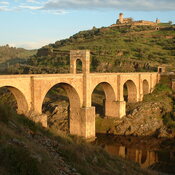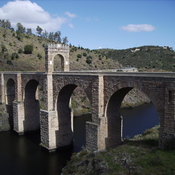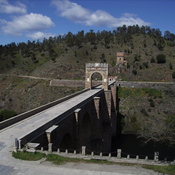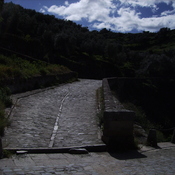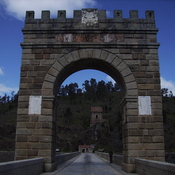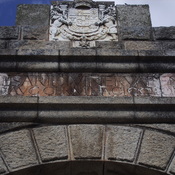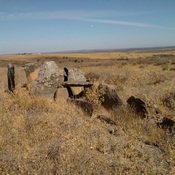Es gibt noch keine deutschsprachige Anmerkungen. Präsentiert wirden Anmerkungen auf English.
The bridge, triumphal arch and temple were all designed by the same architect, Gaius Julius Lacer, who dedicated the latter to the deified emperors of Rome. He concluded his work in 103 AD. The temple was constructed as an offering to Trajan and the gods of Rome.
Alcántara is a small votive temple in antis, rectangular, with a single camera or cell. The temple is constructed of granite. The entrance is flanked by two Tuscan columns and accessed by an exterior staircase, covered with a gabled roof made of slabs of stone, with a pediment with trim at the edges and a smooth tympanum without decoration. Presented in its lintel are inscriptions (now are not original, but subsequent copies) displaying the dedication by the architect Gaius Julius Lacer to the Emperor Trajan.
MP.NERVAE.TRAIANO.CAESARI.AVG.GERM.DAC.SACRVMTemplum in rupe Tagi superis et Caesare plenumars ubi materia vincitur ipsa sua.Quis quali dederit voto fortasse requiretcura viatorum quos nova fama iuvat.Ingentem vasta pontem qui mole peregitsacra litaturo fecit honore Lacer.Qui pontem fecit Lacer et nova templa dicavit,illic se solvunt, hic sibi vota litant.Pontem perpetui mansurum in saecula mundifecit divina nobilis arte Lacer.Idem Romuleis templum cum Caesare divisconstituit felix utraque causa sacri.C.Iulius Lacer H(oc)S(acellum)F(ecit) et dedicavit amico Curio Lacone IgaeditanoHunc titulum procellis abrasum Philippus IV renovari, marmori denuo incidi Elisabeth II decrevit.
Translated:
To Emperor Nerva, Trajan, Caesar Augustus, Germanicus, Dacic, is enshrined
this temple, the live rock of the Tagus, occupied by the Divine and the Caesar,
where the greatness of art itself is overcome by the greatness of the work.
Perhaps the curiosity of the travelers, whom the celebrity of the new it like,
inquire whom and under what vote, offered this temple.
Who built the great bridge of huge factory was Lacer,
to offer with great solemnity the sacrifices.
Who made the bridge, Lacer, also dedicated the new temples:
in that are met his votes, in this devote his offerings.
The illustrious Lacer, with divine art, made the bridge
to would last forever in the perpetuity of the world.
He happily carried out the temple and the bridge
devoted to the Roman gods along with Caesar, one and other work.
Gaius Julius Lacer did this chapel and dedicated it to his friend Curio Larcon Igaeditano
This sign, weathered for the storm, sent him to renew Philip IV and sent him back to record in marble Isabel II.
Istof the only two Roman temples preserved nearly complete in Spain.




